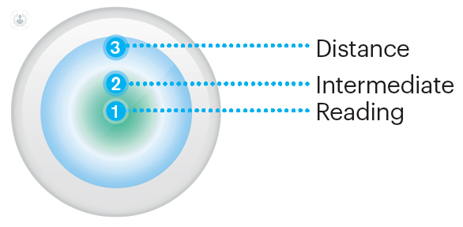Beyond reading glasses: treatments for presbyopia
Written by:Some people may notice that their eyes gradually lose the ability to focus on nearby objects during their early 40s to mid-60s. This is known as presbyopia and the most common treatment for the condition is reading glasses. Some may not be able to escape presbyopia, even if they have never had a problem before. We asked one of our expert ophthalmologists, Professor Sunil Shah, to explain every option available and the pros and cons of each one.

What are my options for presbyopia?
If you have to hold your smartphone further from your eyes to read then it’s time to visit your specialist to discuss the following treatment options:
Reading glasses
Reading glasses are the safest option and pose no risk to the eyes. Varifocal lenses (multifocal lenses) correct vision at different working distances. There is a gradual change in lens strength from the top of the lens to the bottom. If you are looking into the distance, you look through the top of the lens and if you are looking at something closer, you move your eyes lower.
Glasses are inconvenient and may easily be broken, or they often become dirty. The cheap over-the-counter ones have poor lens quality and if you forget to bring them to work one day, there is no easy solution. Varifocal lenses may also take some time to get used to.
Multifocal contact lenses
These contact lenses correct distance as well as reading ability throughout most of the day. They are removable and reversible, and a great option for people who are used to wearing lenses.
As vision changes when blinking, some people may notice blurring and may not like the visual quality, which is based on the design of the lens. Some people complain of halos and glare.
Multifocal contact lenses are not suitable for people with dry eye or contact lens intolerance. About 1 in 500 wearers per year report of risks of contact lens-related inflammatory conditions or infections.
Laser eye surgery
This is more complicated as laser eye surgery generally treats eyes for distance so one needs to compromise on the treatment.
One option is monovision where one eye is corrected for distance and one for reading. This enables the distance eye to only see further away and the near eye to only see much closer.
Another option, which is a different type of compromise, is presbyopia laser treatment. There are different varieties of this depending on the different laser manufacturer. Often there is a small amount of monovision there too as they change the shape of the cornea to increase the depth of focus.
Monovision is a compromise where you can’t use both eyes together. Some people, especially those who have trialled it in contact lenses, love it but a portion (about a third) dislike it. Presbyopia laser surgery changes the higher order aberrations (quality of vision) to allow you to read.
Lens exchange
Lens exchange is the most common surgical operation performed that rectifies both distance and near vision. It is the same as a cataract operation and is the procedure of choice for early cataracts. However, it also means that cataracts can’t develop if this procedure is performed. The risks of the procedure are the same as a cataract operation.
The options are to perform surgery and choose an implant that corrects what you want it to. One can have a single vision implant that permanently corrects both eyes for distance, single vision with one eye for distance and one for near, however, it is more likely to have a multifocal implant that gives both distance and near in both eyes.
There are a variety of multifocal implants and designs and one needs to discuss with their surgeon which is most suitable for them. These include standard multifocals, segmented bifocals and trifocals.
There is a risk of halos, glare and reduced contrast and therefore the design of the implant has to be chosen carefully with the patient.
There is always a small compromise with multifocal lenses but I am able to use multifocal lenses in more than 95% of my patients (usually with femtosecond laser lens surgery).
Corneal inlay
Corneal inlay has largely gone out of favour. The types include one that creates a pinhole to increase the depth of focus or one that increases reading ability by changing the central corneal shape. Whilst theoretically they are reversible, the reality is that they are removable and any damage that has been done to the cornea will still be there. In the UK, these never gained favour as the problems were recognised.
What does future treatment of presbyopia look like?
There are new devices in trial. One very exciting device that I have been working with is called Laserace, which just corrects for reading without compromising distance in any way. It will be available later in 2019.
If you are concerned that you have presbyopia then do not hesitate to book an appointment and have your eyes examined.


